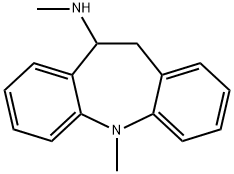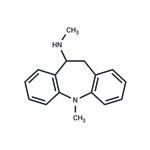Description
Metapramine is an antidepressant with a pharmacological profile similar to the
tricyclics and an apparent rapid clinical onset of action. Metapramine differs
biochemically from the tricyclics in that it markedly enhances norepinephrine
turnover with minimal inhibition of reuptake. Like the tricyclics, however, it does
down regulate β-receptors.
Manufacturing Process
5-Methyl-dibenzo[b,f]azepine (4.1 g), N-diethylaminoborane (1.7 g) and freshly distilled toluene (150 cc) are introduced into a 500 cc three-neck flask equipped with a dropping funnel and a condenser, and protected against moisture by a calcium chloride guard tube. The solution is heated under reflux (110°C) for 22 hours under a nitrogen atmosphere and then cooled. A 2 N aqueous sodium hydroxide solution (33 cc) is then run in followed by an 0.316 N aqueous methylchloramine solution (190 cc), the addition of which takes 9 minutes. The mixture is stirred for 1 hour and then decanted. The organic layer is washed with water until it has a pH of 6 and is then extracted with 2 N hydrochloric acid (5 times 50 cc), dried over sodium sulfate, filtered and evaporated. Recrystallization of the residue from petroleum ether yields some unconverted 5-methyl-dibenzo[b,f]azepine (2.17 g).
The aqueous acid solution is rendered alkaline by adding 2 N sodium hydroxide solution. After extracting with diethyl ether (3 times 100 cc), drying the extracts over potassium carbonate, treating them with decolorizing charcoal, filtering and evaporating the ether, a yellowish oil (0.9 g), identified as 5-methyl-10-methylamino-10,11-dihydrodibenzo[b,f]azepine, is obtained in
a yield of 37.5%.
Methylchloramine can be prepared by adding an aqueous solution of sodium
hypochlorite to an aqueous solution of methylamine in accordance with the
process described by W.S. Metcalf, J. Chem. Soc.1942,148.


